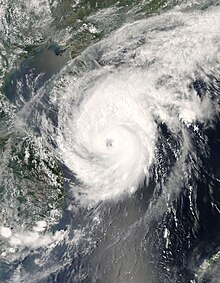 Typhoon Neoguri near peak intensity on April 17 | |
| Meteorological history | |
|---|---|
| Formed | April 13, 2008 |
| Extratropical | April 20, 2008 |
| Dissipated | April 21, 2008 |
| Typhoon | |
| 10-minute sustained (JMA) | |
| Highest winds | 150 km/h (90 mph) |
| Lowest pressure | 960 hPa (mbar); 28.35 inHg |
| Category 3-equivalent typhoon | |
| 1-minute sustained (SSHWS/JTWC) | |
| Highest winds | 185 km/h (115 mph) |
| Lowest pressure | 948 hPa (mbar); 27.99 inHg |
| Overall effects | |
| Fatalities | 26 total |
| Damage | $65 million (2008 USD) |
| Areas affected | Philippines, China |
| IBTrACS | |
Part of the 2008 Pacific typhoon season | |
Typhoon Neoguri (pronounced [nʌ.ɡu.ɾi]), known in the Philippines as Typhoon Ambo, was the earliest tropical cyclone on record to strike China. The first named storm in the 2008 Pacific typhoon season, named after the Korean word for raccoon dog, it formed from a low pressure area on April 13 to the east of the Philippine island of Mindanao, and after crossing the island it intensified into a tropical storm in the South China Sea. Environmental conditions allowed for quick strengthening, with Neoguri attaining typhoon status on April 16. The typhoon reached its peak intensity on April 18 as it approached the island of Hainan, and subsequently it turned northward. Due to increased wind shear and cooler waters, Neoguri rapidly weakened and made landfall as a minimal tropical storm in southern China on April 19.
In the southern Philippines, the storm brought heavy rainfall, which left a person missing when a boat capsized. The typhoon left 40 fishermen missing in the South China Sea. Neoguri brought heavy rainfall as it made its final landfall on China, causing moderate damage totaling over ¥296 million (2008 RMB, $42 million 2008 USD). Three deaths occurred in China.